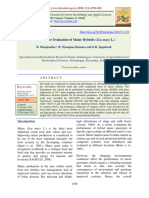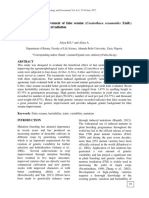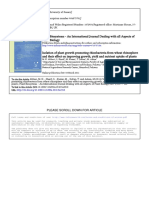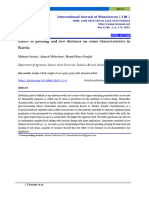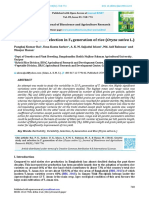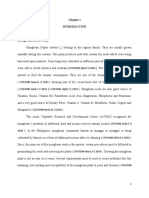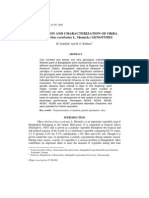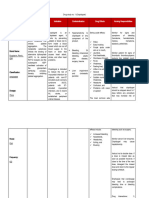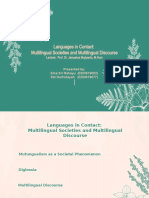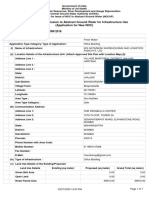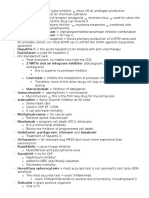Assessment of Gamma Ray Irradiation Effects On Germination and Some Morphological Characters in Tow Corn Cultivars
Assessment of Gamma Ray Irradiation Effects On Germination and Some Morphological Characters in Tow Corn Cultivars
Uploaded by
galeCopyright:
Available Formats
Assessment of Gamma Ray Irradiation Effects On Germination and Some Morphological Characters in Tow Corn Cultivars
Assessment of Gamma Ray Irradiation Effects On Germination and Some Morphological Characters in Tow Corn Cultivars
Uploaded by
galeOriginal Description:
Original Title
Copyright
Available Formats
Share this document
Did you find this document useful?
Is this content inappropriate?
Copyright:
Available Formats
Assessment of Gamma Ray Irradiation Effects On Germination and Some Morphological Characters in Tow Corn Cultivars
Assessment of Gamma Ray Irradiation Effects On Germination and Some Morphological Characters in Tow Corn Cultivars
Uploaded by
galeCopyright:
Available Formats
International Journal of Agriculture and Crop Sciences.
Available online at www.ijagcs.com
IJACS/2013/5-11/1235-1244
ISSN 2227-670X 2013 IJACS Journal
Assessment of gamma ray irradiation effects on
germination and some morphological characters in
tow corn cultivars
Ali emrani*1 , Dr.Alireza Razavi2 , Dr.Mohammad Farhad Rahimi3
1. M.Sc Student of Seed Science and Technology, Faculty of Agriculture, Islamic Azad University
, Ashtian Branch, Ashtian , Iran.
2. Department of agriculture, Agricultural Research Center of Mashhad, Mashhad, Iran.
3. Department of Physics, Ferdowsi University of Mashhad, Mashhad, Iran.
Corresponding author: a.emrani3720@gmail.com
ABSTRACT: In this research study, the dose of gamma radiation on seed germination of two cultivars of
maize (single cross 500 and single cross 704), and the mechanisms of the dose required to maximize the
rate and percentage of germination and increased growth of root and shoot Research central Agricultural
Research Laboratory was conducted in Mashhad. The experiment consisted of two corn (single cross 500
and single cross 704) under the influence of gamma radiation (Co-60) with five different dose groups and
a control was carried out for 5 days.3900 seeds of two varieties of maize (cv. 500 and SC704) were used.
Seed treatment using cobalt-60 gamma radiation was in Omid Hospital Mashhad. In this study, six groups
of seeds (zero dose, 100, 200, 400, 600 and 800) were irradiated for 5 days, each day for each group
counted 75 seeds were sown in glass dishes. Germinated seeds counted 4 days after placing the dishes
in the incubator and this 7 days and until that changes in the number of germinated seeds was found
continued. Studied in this experiment were: germination percentage, germination rate, root length, shoot
length and shoot diameter.The results showed that the root and shoot of both cultivars at doses of 400
and 600 cGy and was highest in the third and fourth days. Traits also showed significant reduction in the
dose of 800. SC 500 varieties of treatments for root length, shoot length and germination showed the
superiority of the SC704.
Key words: Gamma rays, The number of days of exposure, Germination, Corn germination
INTRODUCTION
The first developmental stage of the plant is Germination, a critical stage in the life cycle of plants and a
keyprocessinseedlingemergence(DeVilliersetal.,1994).
The first developmental stage of the plant is Germination; this growth stage is strongly influenced by
environmental factors, especially temperature and soil moisture (Basra et al., 2004).
In this context, a solution is needed in order to enhance seed germination and seedling corn, use more of soil
moistureandprovidenutrientsforplantsandsolarradiation.
In this case, the plant will be able to end its development period before early fall stresses (Subedi and ma,
2005).
The results show that emergence and establishment of uniform power plant achieved using power levels to
rapidly seed germination (Afzal et al., 2002; Ashraf and Foolad, 2005; Farooq et al., 2006).
Increasing agricultural production is possible in two ways: increasing acreage and yield per unit area. Due
to limited natural resources (soil, water, etc.) it should be forced to increase the yield per unit area that is the main
farming procedures. The use of improved varieties, history and proper spacing and crop rotation increase
agricultural efficiency and yield per unit area (Khajehpoor, 2000).
World's third most important crop after is corn after wheat and rice. Acreage of this crop in the world in
2007 was about 158 million hectares with production of 790 million tones (FAO., 2007).
Intl J Agri Crop Sci. Vol., 5 (11), 1235-1244, 2013
Low dose of gamma irradiation stimulates cell division and high-dose inhibits cell division due to free radicals and
DNA system damage (Zaka et al., 2004).
High doses of gamma radiation cause DNA damage and expression of genes related to
Callus (Patade et al., 2008).
Shakoor and. Haq created tall and dense lines using gamma ray by Gy100 dose. Haq et al obtained 6 lines gamma
radiationresistanttoelectricityby100-200Gydoses.
The selection in breeding programs to be effective, it is necessary to study the genetic diversity in the
samples (Adu-Dupaah, and Sang Won, 2005).
Kim et al (2004) found that low radiation dose had significant effect on growth parameters and low dose
germination is associated with germination studying on different doses of gamma irradiation (up to 20 Gy) on three
varieties of Chinese cabbage. Since diversity in plant species is low due to breeding strategies and subsequent
erosion of genetic resources, mutation is regarded as a process known to increase genetic diversity (Yilmaz, A.,
and Boydak. 2006).
Mutation creates diversity in genetic potential for emergence that does not occur naturally.
Since spontaneous mutations occur at very low frequency, mutation induction techniques are tools for quickly
creating diversity in plant species (Maluszynski et al., 1995).
Induction mutation is considerable in Understanding the genetic mechanisms specially the structure and
function of genetic material. If the diversity of mutations can be adapted, it will help to survival the remains of
different environments. Despite some limitations in mutation breeding, induced mutation is used for breeding of
plants. The main advantage of the potential of mutation breeding is genetic modification of one or more characters
without changing resources (Wani and Anis, 2008).
Until now, more than 2200 mutants were released from different plants with improved agronomics. The
mutagenic was successfully used to change the genetic structure of crop plants and economic isolation of mutants
with desirable traits such as plant height, number of pods per plant, number of seeds per pod, seed weight, seed
yield, oil content and resistance to disease (Javed et al., 2000).
Effects of gamma rays on quantitative and qualitative characteristics of rice indicated that radiation dose
somewhat improved growth characteristics, but with increasing dose rate, a decreasing trend is observed in the
studiedtraits(Sahaetal.,2005).
Turnip seeds of the four species of 750, 1000 and 1250 Gy gamma rays were selected for desirable traits
that was carried out at various stages of the hundreds of people treated with both mutant and TS96-752 TS951005 titles with improved agronomic traits and the parental lines were more than two thousand seed weight greater
than the parent mutant. It has been noted that the mutagenic effect was probably a result of an increase in grain
size (Javed et al., 2003).
The effect of gibberellin acid biosynthesis or signaling mutations (GA) can produce dwarf phenotypes in
plants and using these mutants in plant breeding, it is an important factor in the success of the Green Revolution,
(Mungprom et al., 2005) dwarf shrubs were created using the HD mutation.
MATERIALS AND METHODS
In this study, 3900 seeds from two varieties of corn (figure 500 and SC704) were used. Seeds were treated
using cobalt-60 gamma rays in Omid Hospital in Mashahd with the following characteristics.
Dose of 155 cGy per minute output
Ssd = 60
Field 20 20
Over Seeds on 0.5 cm wax
RESULTS
The results of variance analysis shows (Table 4.1) that among cultivars for all traits, there were significant
differences in traits except stem diameter that it is a fix character and has not been affected by radiation. As seen
in the table at different doses for all traits except percentage and germination rate, there are significant differences
for other traits. This indicates that radiation levels have a direct effect on cell division and intracellular metabolism
and the length and diameter of the cells. But it has no effect on the rate of intracellular activity.
Intl J Agri Crop Sci.
Sci. Vol., 5 (11),
(
1235-12
244, 2013
The interaction of cultivars in different doses has significant difference at 1% level for all characters except
two traits of germination rate and germination percentage.
percentage The interaction of radiation at different radiation doses
for all characters is shown at 1% level of significance.
significance.
Considering the amount of radiation received by the plant,
plant the greater the amount of energy received per
unit area result in any morphological and physiological changes in plants that is the same with the results of the
study by Hossein Pour and colleagues (2002
2002).
In the study of interactions between genotypes,
genotypes levels of radiation dose and radiation were determined.
determined Significant
difference at 1% level for all traits was observed except germination rate and germination percentage and the
resultsofHosseinPourFeiziandcolleagues(1384)wereconsistent
resultsofHosseinPourFeiziandcolleagues(1384
ofHosseinPourFeiziandcolleagues(1384
consistent.
Table 1. Analysis of variance measure for measured characters (mean square).
S. V.
A cultivars
B irradiation
AB
radiation levels
C
AC
BC
ABC
Error
df
1
4
4
4
4
16
16
100
Percentage of
germination
9157.227**
**
437.227**
ns
204.977
ns
99.610
ns
175.910
40.118 **
ns
41.827
99.400
stem diameter
ns
28.040
4.557 **
0.390 **
ns
16.523
29.323 **
2.794 **
5.486 **
7.707
Germination
rate
343.224 **
ns
4.564
ns
7.290
ns
3.606
ns
7.366
1.647**
ns
4.956
3.415
shoot length
248.327 **
3.310 **
10.343 **
113.527**
**
ns
15.760
10.064 **
29.047 **
13.087
root length
329874.707 **
890.807
890.807**
1305.440 **
15813.007
15813.007**
3567.607 *
1203.369
1203.369**
ns
1530.694
1328.473
ns, * and **: respectively non-significant
significant, significant at the 5 and 1 percent
Root length
In Figure 1,, the effect is independent of the number.
number As it can be seen,
seen the figure of a significant effect on
root growth rate is 1%. The two are distinct and different.
different Single cross of 500 has higher root growth than 704.
O
Overall,
figure of 500 has a shorter growth period and pass deployment stages sooner that shows
show this difference.
difference
Figure 1. Comparison of root length effect on the cultivars tested
It also considers the effect of irradiation on the root growth that was shown by the
radiation
adiation effects on root growth and the highest level of radiation has the fifth lowest impact on root growth.
growth Also,
among the first, second and fourth radiations, there is no significant effect on root growth at 95% confidence level.
Compared with the results of comparing the effects of dose and irradiation on root growth rates in Tables 2, 3, it
ha been identified by the treatment (12 vs. SC 500, 400 and
has
and radiation dose in the second A) that the
he maximum
root growth and treatment (35) (SC704, 200, and radiation dose, V) has the least amount of root growth in 67/29,
respectively.
Intl J Agri Crop Sci.
Sci. Vol., 5 (11),
(
1235-12
244, 2013
Figure 2. the effect of irradiation on root length
The effect of dose level on root growth,, it was determined that 200 cm dose has the highest dose of
irradiation effects on root growth and, as seen, what is the least amount of impact on root growth,
growth ie the
t overall
effect of irradiation on the growth of roots are visible.
effects
visible Doses between 200 and 600 also have significant effects on
root growth at 95% confidence level.
level
Figure 3. the effect of irradiation on root growth
shoot length
In Table 1, the values of shoot elongation ANOVA and Figure (4) figure independent effect are shown,
shown as it
can be seen , the figure has a significant effect on the rate of growth of 1 percent confidence level shoot and figure
500 shows more shoot growth than 704..
Intl J Agri Crop Sci.
Sci. Vol., 5 (11),
(
1235-12
244, 2013
Figure 4.
4 Comparison of shoot length in cultivars tested
The values in Table 1 and Figure ANOVA shoot growth (5) at the 1% level of radiation dose significant
effect on the rate of stem elongation.
elongation
Figure 5 . Effect of radiation levels on shoot growth
It also considers the effect of radiation on shoot growth at 1% confidence level showed a significant effect.
effect
Second radiation has the highest rate of shoot growth 23.667 and emission fifth has the lowest shoot growth rate
18.8, respectively. The interaction effect of variety on the irradiation dose and the number of shoot growth at the
18.8,
table (2) has been determined that the treatment of 31 (SC704,
SC704, 200 dose and first radiation) has the fastest
growing shoot 30 (35) treatments (SC704,
SC704, 200 dose and fifth radiation) of shoot growth is lowest in 13.33.
13.33
Intl J Agri Crop Sci.
Sci. Vol., 5 (11),
(
1235-12
244, 2013
Figure 6. Effect of irradiation on the rate of shoot elongation.
elongation
Germination rate
In table
able (1), the values of ANOVA of germination and in shape (7) as it can be seen the variety has a
significant effect on the germination rate that was 1% confidence level and the number of SC 500 has higher
germination rate than SC704.
SC704
Figure 7.
7 Comparison of germination in cultivars tested
And also the effect of radiation on the radiation dose and speed of germination determined that the
treatments had no significant effect on germination rate that was 5% confidence level.
level
Intl J Agri Crop Sci.
Sci. Vol., 5 (11),
(
1235-12
244, 2013
Figure 8. the effect of different doses of radiation on germination rate
Interaction with the highest radiation dose and the rate of germination in Table (2) has determined that the
treatment (19) (figure SC 500,
500 600 dose and forth radiation) has the maximum germination rate of 18.73 and
treatment 45 (SC704,
SC704, 600 dose,
dose and fifth radiation) has the minimum germination rate 11.90.
11.90
Figure 9. Effect of irradiation on germination rate.
rate
Percentage of germination
In table
able (1) ANOVA values for germination and in shape (10)
10) the independent effect of the number
number, as you
can see,
see, the figure has a significant effect on germination percentage 99% confidence level showed higher
germination rate of SC 500..
Figure 10 .Comparison
Comparison of seed germination
Intl J Agri Crop Sci.
Sci. Vol., 5 (11),
(
1235-12
244, 2013
On the other hand, the effect of irradiation dose and the number has determined that these two Parameters
Parameter
and significant do not effect on germination percentage (95%).
Figure 11. Effect of different levels of radiation on germination
The figures in Table 2 Interaction between dose and radiation on seed germination has been observed to be
treated as 19 (figure
(
SC 500,
500 600 dose and fifth radiation) has the
he maximum germination percentage of 99.67 and
(45) treatment (SC704, 600 dose and fifth radiation) has the minimum germination rate 63.33.
63.33
Figure 12.
12 Effect of irradiation on germination.
diameter of the shoot
In table
able 1 ANOVA values stem diameter and number of radiation in the form of (13) and (14) cultivar effects
on stem diameter,
diameter as it is seen,
seen in a variety there is not a significant effect on stem diameter at 0.95 confidence
level
level.
Figure 13. Comparison of stem diameter in both cultivars tested
And also it results in the form of radiation dose levels (15)
15) on stem diameter at 95% confidence level that
showed no significant difference.
difference
Intl J Agri Crop Sci.
Sci. Vol., 5 (11),
(
1235-12
244, 2013
Figure 14. Effect of irradiation on stem diameter
The independent effect of variety on the irradiation dose and the number of stem diameter at the table (2)
has been determined that the treatment number 20 (figure SC 500, 600 and fifth radiation) has the largest diameter
shoot 19.67 and treated with 40 (vs. SC 500, 400 and fifth radiation) has the minimum percentage of germination,
germin
67/13 It should be noted that the other treatments had no significant difference at 95% confidence level.
Figure 15. Effect of different levels of radiation on stem diameter.
diameter
Table 2. Comparison of different radiation treatments in the number of SC 500
Treatment
doses
radiation
1
2
3
4
5
6
7
8
8
10
11
12
13
14
15
16
17
18
19
20
21
22
23
24
25
100
100
100
100
100
200
200
200
200
200
400
400
400
400
400
600
600
600
600
600
800
800
800
800
800
1
2
3
4
5
1
2
3
4
5
1
2
3
4
5
1
2
3
4
5
1
2
3
4
5
stem
diameter
ab
15.00
ab
16.00
ab
15.00
ab
18.33
ab
17.67
ab
16.33
ab
16.00
ab
15.00
ab
18.67
ab
19.33
ab
16.00
ab
14.33
ab
16.00
ab
18.33
ab
19.33
ab
14.67
ab
17.33
ab
14.33
ab
18.33
a
19.67
ab
15.00
ab
16.33
ab
15.33
ab
19.33
ab
15.33
Percentage
germination
ae
90.67
ae
90.33
ai
83.00
ac
96.00
ag
86.00
ai
83.00
ai
81.67
ci
76.00
ad
93.33
ag
86.67
ai
82.67
ad
93.00
ac
96.00
ac
96.00
af
89.33
ah
84.67
ag
85.33
ag
86.67
a
99.67
ab
97.67
af
90.00
af
89.67
ad
93.33
ag
87.00
ac
95.67
germination
rate
ad
17.13
ad
17.07
ai
15.60
ab
18.27
ag
16.20
ah
15.73
ai
15.50
ci
14.23
ac
17.60
ae
16.43
ah
15.77
ac
17.57
ab
18.03
ab
18.03
ad
16.87
ag
16.10
ag
16.13
af
16.27
a
18.73
ab
18.00
ad
16.97
ad
16.93
ac
17.50
ae
16.40
ab
18.03
shoot length
ae
26.00
ac
27.00
bg
20.67
fh
18.33
ch
20.00
bh
20.33
ad
26.67
bg
22.33
bg
22.33
bg
20.67
ag
23.33
ac
27.00
ag
23.00
bg
22.67
bg
20.67
ab
27.67
bg
22.67
bg
21.33
bg
20.67
bg
21.33
ag
23.33
ag
23.33
bg
22.00
bg
21.67
bg
22.67
Root length
ae
191.3
ab
207.7
bl
136.0
ah
168.7
bl
136.7
al
142.0
af
182.3
dn
129.3
ac
202.7
dn
122.3
bm
135.0
a
214.3
ak
144.3
ae
190.7
ai
163.0
ab
206.7
ag
176.3
gq
105.7
af
181.3
ah
169.3
ae
190.7
ad
194.3
dn
128.7
ah
171.7
aj
160.7
Similar letters in each column,, the difference in the level of P <0.05 were not significantly different.
different
Intl J Agri Crop Sci. Vol., 5 (11), 1235-1244, 2013
Continued Table 2. Comparison of different treatments of radiation on the SC704
Treatment
26
27
28
29
30
31
32
33
34
35
36
37
38
39
40
41
42
43
44
45
46
47
48
49
50
doses
100
100
100
100
100
200
200
200
200
200
400
400
400
400
400
600
600
600
600
600
800
800
800
800
800
radiation
1
2
3
4
5
1
2
3
4
5
1
2
3
4
5
1
2
3
4
5
1
2
3
4
5
stem
diameter
ab
14.33
ab
18.33
ab
15.67
ab
15.33
ab
14.33
ab
17.00
ab
17.00
ab
16.67
ab
15.00
ab
17.00
ab
14.33
ab
18.33
ab
15.67
ab
17.33
b
13.67
ab
16.67
ab
15.33
ab
15.67
ab
15.00
ab
16.00
ab
16.00
ab
15.33
ab
14.67
ab
15.00
ab
15.33
Percentage
germination
ei
71.00
ai
83.33
ci
77.33
ci
76.00
ah
84.00
ci
75.67
ah
83.67
di
73.00
fi
69.67
gi
68.00
ah
84.00
ci
68.00
di
73.67
ai
82.67
ei
72.33
di
74.33
ci
75.67
gi
68.33
gi
67.00
i
63.33
hi
65.00
bi
78.00
ei
71.33
ei
72.67
ei
64.67
germination
rate
di
13.47
ah
15.77
bi
14.70
ci
14.27
ah
15.80
ci
14.27
ah
15.83
di
13.73
ei
13.00
ei
12.80
ah
15.80
ei
12.77
ci
13.87
ai
15.53
fi
12.60
ci
14.07
ci
14.27
ei
12.90
gi
12.47
i
12.90
hi
12.23
bi
14.63
di
13.43
di
13.60
hi
12.13
shoot length
bg
21.67
dh
19.33
bg
22.67
eh
19.00
fh
17.33
a
30.00
ag
23.33
fh
17.67
eh
18.67
h
13.33
eh
19.00
bh
20.33
gh
16.67
bg
21.00
gh
16.67
eh
19.00
af
24.33
bg
21.33
bg
21.67
eh
19.00
ch
19.67
bg
22.67
bg
20.67
bg
22.00
gh
16.33
Root length
js
88.33
eo
120.70
hs
99.33
ks
84.67
ps
47.00
cn
131.00
fp
113.00
ns
61.33
ps
40.00
s
29.67
ls
69.67
ps
48.00
os
48.67
is
95.33
rs
32.00
gr
103.7
ks
67.67
ns
60.33
ms
62.33
qs
37.00
is
93.33
is
95.67
ps
46.67
ls
71.00
ps
47.67
Similar letters in each column, the difference in the level of P <0.05 were not significantly different.
REFERENCES
Adu-Dupaah HK, Sang Won RS. 2005. Improving bambra groundnut productivity using gamma irradiation and in vitro techniques. African
Journal of Biotechnology, 3: 5. 260-265.
Afzal A, Aslam N, Mahmood F, Hameed A, Irfan S, Ahmad G. 2006. Enhan cement of germination and emergence of canola seeds by different
priming Techniques. Garden depesquisa Bio. 16(1):19- 34.
Ashraf M, Foolad MR. 2005. Pre- sowing seed treatment- a shotgun approach to improve germination growth and crop yield under saline and
none- saline conditions. Advan. Agron. 88: 223- 271.
Basra SMA, M Ashraf, N Iqbal, A Khaliq, Ahmad R. 2004. Physiological and biochemical aspects of pre- sowing heat stress on cottonseed.
Seed Sci and Technol. 32: 765-774.
De Villiers AJ, Van Rooym MW, Theron GK, Van Deventer HA.1994. Germination of three namaqual and pioeer species, as influenced by
salinity, yempera ture and light. Seed Sci and Technol. 22:427- 433.
Food and Agricultural Organization. 2007. Production and trade yearbook, 2006. FAO, Rome, Italy.
Javed MA, Khatri A, Khan IA, Ahmad M, Siddiqui MA, Arian AG. 2000. Utilization of gamma irradiation for the genetics improvement of oriental
mustar (Brassica juncea). Pak. J. Bot. 32: 77-83.
Javed MA, Siddiqui MA, Kashif M, Khatri A, Khan IA, Dahar NA, Khanzada MH, Khan R. 2003. Development of high yielding mutants of
Brassica campestris L. cv. Toria selection through gamma rays irradiation. Plant Sci. 2: 192-195.
Khajehpoor MR. 2000. Principles and Fundamentals of Agronomy. Isfehan University of Technology. 412 pp.
Kim JS, Beek MH, Lee YK, Park YI. 2004. Stimulating effect of low dose gamma ray radiation on the growth and physiological activities of
Chinese cabbage cultivars. www.http:// csiro/ publish.com
Maluszynski M, Beanet SA, Bojorn S. 1995. Application of in vitro and in vivo mutation techniques for crop improvement. Euphytica. 85: 303307.
Mungprom A, Thomas SG, Sun T, Osborn TC. 2005. A novel dwarfing mutation in a green revolution gene from Brassica rapa. Plant Physiol.
Rev. 10: 1104 pp.
Patade Y, Suprasanna P, Bapat VA. 2008. Gamma Irradiation of Embryogenic Callus Cultures and in vitro Selection for Salt ToLerance in
Sugarcane (Saccharum officinaram L.). Agricultural Sciences in China, 7(9): 1147 1152.
Saha A, Santra SC, Chanda S. 2005. Modulation of some quantitative characteristics in rice (Orayza sativa) by ionizing radiation. Radiat.
Physic. Chem. 74: 391-394.
Subedi KD, Ma BL. 2005. Seed priming does not improven corn yield in a humid temperate environment. Agron. J. 97:211-218.
Wani A, Anis M. 2008. Gamma Ray- and EMS-Induced Bold-Seeded High-Yielding mutants in chickpea (Cicer arietinum). Turk. J. Biol.. 32: 1-5.
Yilmaz A, Boydak. 2006. The effects of cobalt-60 applications on yield components of cotton (Gossypium barbadense L.). Pakistan Journal of
Biological Sciences, 9: 15. 2761-2769.
Zaka R, Chenal C, Misset MT. 2004. Effects of low doses of short term gamma irradiation on growth and development through two generations
of Pisum sativam Science of the Total Environment, 320:121 129
You might also like
- Adeleye Adeyemi CV For CleanerDocument3 pagesAdeleye Adeyemi CV For Cleanerpaul adeleye100% (1)
- InvocationDocument3 pagesInvocationDavid Rojas100% (1)
- Sample Makemytrip Flight TicketDocument3 pagesSample Makemytrip Flight TicketShaishab DasNo ratings yet
- Habitat For Humanity: Great BritainDocument40 pagesHabitat For Humanity: Great BritainEdwardNo ratings yet
- EJPB - Volume 26 - Issue 2 - Pages 279-296Document18 pagesEJPB - Volume 26 - Issue 2 - Pages 279-296Mourad TaibiNo ratings yet
- Article1380793728 - Piri Et AlDocument6 pagesArticle1380793728 - Piri Et Allama agsamNo ratings yet
- Performance Evaluation of Maize HybridsDocument6 pagesPerformance Evaluation of Maize Hybridscaterine patricia inoñan yanayacoNo ratings yet
- Effect of Mutagens On Frequency and Spectrum of Viable Mutations in Horsegram (Macrotyloma Uniflorum (Lam.) Verdc)Document11 pagesEffect of Mutagens On Frequency and Spectrum of Viable Mutations in Horsegram (Macrotyloma Uniflorum (Lam.) Verdc)International Organization of Scientific Research (IOSR)No ratings yet
- Induced Variability by Gamma Irradiation in Isabgol (Plantago Ovata Forsk)Document6 pagesInduced Variability by Gamma Irradiation in Isabgol (Plantago Ovata Forsk)TJPRC PublicationsNo ratings yet
- Effects of Azospirillum Bacteria and Cytokinin MaizeDocument9 pagesEffects of Azospirillum Bacteria and Cytokinin MaizeAna Laura Topanott NunesNo ratings yet
- 4-Aliyu-Ajate - Vol 6 No 1Document10 pages4-Aliyu-Ajate - Vol 6 No 1SINI DELINo ratings yet
- Dissertation-Saumya TewariDocument43 pagesDissertation-Saumya Tewari28 Bushra RahmanNo ratings yet
- Genetic Variability, Association and Path Analysis in Mung Bean (Vigna Radiata L.)Document7 pagesGenetic Variability, Association and Path Analysis in Mung Bean (Vigna Radiata L.)International Network For Natural SciencesNo ratings yet
- B ManjunathaetalMaize21 11 2018Document7 pagesB ManjunathaetalMaize21 11 2018caterine patricia inoñan yanayacoNo ratings yet
- Jurnal Pendahuluan PadiDocument10 pagesJurnal Pendahuluan PadiRizky MaulanaNo ratings yet
- Mutagenic Effects of Sodium Azide On The Quality of Maize SeedsDocument7 pagesMutagenic Effects of Sodium Azide On The Quality of Maize SeedsKanhiya MahourNo ratings yet
- Agri Sci - Jasr - Assessment of Herbicide AlachlorDocument8 pagesAgri Sci - Jasr - Assessment of Herbicide AlachlorTJPRC PublicationsNo ratings yet
- 2015 Issue1Document122 pages2015 Issue1Mahesh GunnalaNo ratings yet
- 14 JTAS-1062-2017-5thProofDocument16 pages14 JTAS-1062-2017-5thProofwafaa baghdadNo ratings yet
- Gamma RadiationDocument5 pagesGamma RadiationMahzad SareerNo ratings yet
- Response of Melon Accessions To Doses of Co60 Gamma Rays and Their Effects On The Morphology of The M1 GenerationDocument9 pagesResponse of Melon Accessions To Doses of Co60 Gamma Rays and Their Effects On The Morphology of The M1 GenerationDaniel M. FernandesNo ratings yet
- 17.fathur Maret 2017 Eec23Document5 pages17.fathur Maret 2017 Eec23Heriyanto UIRNo ratings yet
- Effect of Magnetic Field Treatment On Seed Germination Period and Germination Success Rate. Evangelina Crew Research Report 2024Document10 pagesEffect of Magnetic Field Treatment On Seed Germination Period and Germination Success Rate. Evangelina Crew Research Report 2024evangelina crewNo ratings yet
- EJDR - Volume 72 - Issue 1 - Pages 73-87Document15 pagesEJDR - Volume 72 - Issue 1 - Pages 73-87Magali Ruiz RivasNo ratings yet
- tmpEDC0 TMPDocument11 pagestmpEDC0 TMPFrontiersNo ratings yet
- Ahn 2005 AllelopathyDocument7 pagesAhn 2005 AllelopathyTran Dang KhanhNo ratings yet
- Effect of Pruning and Row Distance On Some Characteristics in KarelaDocument8 pagesEffect of Pruning and Row Distance On Some Characteristics in KarelaOpenaccess Research paperNo ratings yet
- Article - Effect of Seed HardeningDocument14 pagesArticle - Effect of Seed HardeningDharmendra MauryaNo ratings yet
- Induction of Genetic Variability Through Mutagenesis in Sorghum (Sorghum Bicolor (L.) Moench)Document4 pagesInduction of Genetic Variability Through Mutagenesis in Sorghum (Sorghum Bicolor (L.) Moench)divspatel83No ratings yet
- tmp43EC TMPDocument7 pagestmp43EC TMPFrontiersNo ratings yet
- tmp9487 TMPDocument9 pagestmp9487 TMPFrontiersNo ratings yet
- Influence of Organic and Inorganic Fertilizers On Growth, Yield and Physio-Chemical Properties of PapayaDocument16 pagesInfluence of Organic and Inorganic Fertilizers On Growth, Yield and Physio-Chemical Properties of Papayamwah mwahNo ratings yet
- Dhungana Et Al-2015-Journal of Agronomy and Crop ScienceDocument7 pagesDhungana Et Al-2015-Journal of Agronomy and Crop ScienceAzhari RizalNo ratings yet
- 2014 NullDocument6 pages2014 NullrazhulashikNo ratings yet
- 002 Sjfop-24 OentheraDocument18 pages002 Sjfop-24 Oentherataiar2010No ratings yet
- Correlations SFDocument3 pagesCorrelations SFCatur S KurniaNo ratings yet
- Result of Chemical Mutagenesis On Quantitative As Well As QualitativeDocument4 pagesResult of Chemical Mutagenesis On Quantitative As Well As QualitativeMuhammad RehanNo ratings yet
- Effect of Different Types of Abiotic Stress On The Growth and Productivity of Linseed (Linum Usitatissimum L.)Document7 pagesEffect of Different Types of Abiotic Stress On The Growth and Productivity of Linseed (Linum Usitatissimum L.)michael 65No ratings yet
- Genetic Study and Selection in F4 Generation of Rice (Oryza Sativa L.)Document7 pagesGenetic Study and Selection in F4 Generation of Rice (Oryza Sativa L.)MonjurNo ratings yet
- Complete Synopsis PriyankaDocument14 pagesComplete Synopsis PriyankaPikku kumariNo ratings yet
- Impact of Plant Growth Regulators On Okra Seed Quality andDocument6 pagesImpact of Plant Growth Regulators On Okra Seed Quality andShailendra RajanNo ratings yet
- CITATION Opl13 /L 1033Document19 pagesCITATION Opl13 /L 1033Jhune Dominique GalangNo ratings yet
- Rajesh SYNOPSIS-3Document17 pagesRajesh SYNOPSIS-3FLASH CLASHNo ratings yet
- Induced Mutagenesis of Flowering, Phenology and Yield in M1 Generation of Bambara Groundnut Vigna Subterrnea L. VerdcDocument9 pagesInduced Mutagenesis of Flowering, Phenology and Yield in M1 Generation of Bambara Groundnut Vigna Subterrnea L. VerdcEditor IJTSRDNo ratings yet
- Effect of Rust On Paddy FieldDocument6 pagesEffect of Rust On Paddy FieldGanesh JadhavNo ratings yet
- Influence of Planting Date and Plant Density On Morphological Characteristics, Seed Yield and Essential Oil Percentage of Oregano (Origanum Vulgare L.)Document6 pagesInfluence of Planting Date and Plant Density On Morphological Characteristics, Seed Yield and Essential Oil Percentage of Oregano (Origanum Vulgare L.)Shailendra RajanNo ratings yet
- Effect of Seed Priming On Seed Quality of Tomato (Solanum Lycoperscium L.)Document4 pagesEffect of Seed Priming On Seed Quality of Tomato (Solanum Lycoperscium L.)Cedrus CedrusNo ratings yet
- Manuscript 2023Document26 pagesManuscript 2023rodrigoNo ratings yet
- Nitro Kara ZimbaveDocument12 pagesNitro Kara Zimbavesiamak77No ratings yet
- Influence of Plant Growth Regulators (Ga) and (Naa) On Growth and Yield Attributes of Brinjal (Solanum Melongena L.)Document6 pagesInfluence of Plant Growth Regulators (Ga) and (Naa) On Growth and Yield Attributes of Brinjal (Solanum Melongena L.)Vijayalakshmy GovindNo ratings yet
- Strategies For in Vitro Propagation and Synthetic Seeds in BananaDocument9 pagesStrategies For in Vitro Propagation and Synthetic Seeds in BananaWidya Setiabudi AseliNo ratings yet
- Breeding For Fusarium Wilt Resistance and Some Economic Characters in CucumberDocument10 pagesBreeding For Fusarium Wilt Resistance and Some Economic Characters in CucumberShailendra RajanNo ratings yet
- Effect of Plant Growth Regulators and Stage of Application On Morphological and Yield Parameters of Bitter Gourd Cv. VK-1 PriyaDocument5 pagesEffect of Plant Growth Regulators and Stage of Application On Morphological and Yield Parameters of Bitter Gourd Cv. VK-1 PriyasyamkavithaNo ratings yet
- Effect of Physical Mutagen On Growth and Quality Characters of Tuberose (Polianthes Tuberosa L.)Document5 pagesEffect of Physical Mutagen On Growth and Quality Characters of Tuberose (Polianthes Tuberosa L.)mohapatra1996No ratings yet
- FoliarDocument8 pagesFoliarjustine pepitoNo ratings yet
- Pre-Sowing Seed Magnetic Field Stimulation - A Good Option To Enhance Bitter Gourd Germination, Seedling Growth and YiDocument8 pagesPre-Sowing Seed Magnetic Field Stimulation - A Good Option To Enhance Bitter Gourd Germination, Seedling Growth and YiAngela Rodriguez ForeroNo ratings yet
- Changes in Some Physiological Traits and Yield of Corn in Response To Cover CropsDocument10 pagesChanges in Some Physiological Traits and Yield of Corn in Response To Cover CropsOpenaccess Research paperNo ratings yet
- Evaluation Characterization OkraDocument8 pagesEvaluation Characterization OkraNida HussainNo ratings yet
- IJB Vol 16 No 5 P 280 283Document4 pagesIJB Vol 16 No 5 P 280 283S M Nazmul SumonNo ratings yet
- TH 9769Document80 pagesTH 9769Atul PharateNo ratings yet
- Implications of Somaclonal Variation in Vitro in Crop Management: A ReviewDocument11 pagesImplications of Somaclonal Variation in Vitro in Crop Management: A ReviewAnthony EmaruNo ratings yet
- Review-Somaclones0001Document4 pagesReview-Somaclones0001Vanlalruati SailoNo ratings yet
- Increasing Solar Radiation Use Efficiency (RUE) of Maize (Zea Mays L.) Through Arranging The Layout of Several Intercrop PlantsDocument9 pagesIncreasing Solar Radiation Use Efficiency (RUE) of Maize (Zea Mays L.) Through Arranging The Layout of Several Intercrop PlantsMamta AgarwalNo ratings yet
- Agarose Gel ElctrophoresisDocument9 pagesAgarose Gel ElctrophoresisgaleNo ratings yet
- Lab Exercise 3 Tabular PresentationDocument2 pagesLab Exercise 3 Tabular PresentationgaleNo ratings yet
- Disaster Risk Reduction and Management Information Report: 12 - KalantasDocument5 pagesDisaster Risk Reduction and Management Information Report: 12 - KalantasgaleNo ratings yet
- Telephone No.: (02) 521 8647: St. Luke'S Medical Center Extension Clinic - ManilaDocument1 pageTelephone No.: (02) 521 8647: St. Luke'S Medical Center Extension Clinic - ManilagaleNo ratings yet
- Gale J. Austria: Files To Be SubmittedDocument1 pageGale J. Austria: Files To Be SubmittedgaleNo ratings yet
- DRUG STUDY (Clopidogrel)Document7 pagesDRUG STUDY (Clopidogrel)Fatima MohammedNo ratings yet
- Language in ContactDocument19 pagesLanguage in ContactEmma Sri Rahayu100% (1)
- FU-M1-CU2 Health, Illness and Filipino Culture, VAlues and PracticesDocument10 pagesFU-M1-CU2 Health, Illness and Filipino Culture, VAlues and PracticesJared Dela cruzNo ratings yet
- Webpath CNSDocument20 pagesWebpath CNSchichandesuNo ratings yet
- CHE124 C1901 Topics PDFDocument2 pagesCHE124 C1901 Topics PDFintustan leeNo ratings yet
- Death by ChocolateDocument4 pagesDeath by Chocolatevishal_lal89No ratings yet
- Lyrics of Friend of MineDocument1 pageLyrics of Friend of Minecayla mae carlosNo ratings yet
- Infrastructure Use Application For ExternalDocument7 pagesInfrastructure Use Application For ExternalAnshul YadavNo ratings yet
- Week 006-Module 006-Ballroom DancingDocument7 pagesWeek 006-Module 006-Ballroom DancingJohnloyd LapiadNo ratings yet
- Elkem InoculacaoDocument26 pagesElkem Inoculacaoeduardolavrati100% (1)
- New Alacarte FormDocument2 pagesNew Alacarte FormVarinder AnandNo ratings yet
- Info University Pre Enrollment DOV Study Visa 2024Document3 pagesInfo University Pre Enrollment DOV Study Visa 2024ahsan4naeemNo ratings yet
- Kelas Kick BoxingDocument5 pagesKelas Kick BoxingNurhazwaniSyahrinNo ratings yet
- 16 Basic DesiresDocument30 pages16 Basic DesiresnboobeshkumarNo ratings yet
- 1630559194-Current Affair August Month 2021Document44 pages1630559194-Current Affair August Month 2021Himanshu BhatiNo ratings yet
- SPDIF Optical To AESEBU - Digital Audio Interface Hosa CablesDocument1 pageSPDIF Optical To AESEBU - Digital Audio Interface Hosa Cablesdino trifunovicNo ratings yet
- Fischer's CramathonDocument3 pagesFischer's CramathonRaymond KwokNo ratings yet
- Daftar Harga Produk Pt. Pyridam (Divisi Ethical) Efektif: 01 NOVEMBER 2022Document12 pagesDaftar Harga Produk Pt. Pyridam (Divisi Ethical) Efektif: 01 NOVEMBER 2022KikkyNo ratings yet
- (Advances in Intelligent Systems and Computing 456) Maria Brigida Ferraro, Paolo Giordani, Barbara Vantaggi, Marek Gagolewski, María Ángeles Gil, Przemysław Grzegorzewski, Olgierd Hryniewicz (Eds.)-SoDocument538 pages(Advances in Intelligent Systems and Computing 456) Maria Brigida Ferraro, Paolo Giordani, Barbara Vantaggi, Marek Gagolewski, María Ángeles Gil, Przemysław Grzegorzewski, Olgierd Hryniewicz (Eds.)-SoHernánQuirozNo ratings yet
- Ship Particular 22-05Document1 pageShip Particular 22-05Agung FarandyNo ratings yet
- Lecture 1: An Introduction To CUDA: Mike GilesDocument40 pagesLecture 1: An Introduction To CUDA: Mike Gilessdancer75No ratings yet
- Socials - 00 - Ngo Unit PlanDocument4 pagesSocials - 00 - Ngo Unit Planapi-526315392No ratings yet
- 6bd - Namport Tariff Booklet 2023 - 2024 WebDocument72 pages6bd - Namport Tariff Booklet 2023 - 2024 WebEmp.smith NamuloNo ratings yet
- September 13, 2019 Evelyn R. Lim Hrmo Lignon Hill, Bogtong Legazpi City 4500Document2 pagesSeptember 13, 2019 Evelyn R. Lim Hrmo Lignon Hill, Bogtong Legazpi City 4500Clariza Nuyles100% (1)
- 7522 ConsolidationDocument50 pages7522 ConsolidationMmm MmmNo ratings yet
- CUADERNILLO 3RO InglesDocument17 pagesCUADERNILLO 3RO InglesAndriu MennaNo ratings yet






